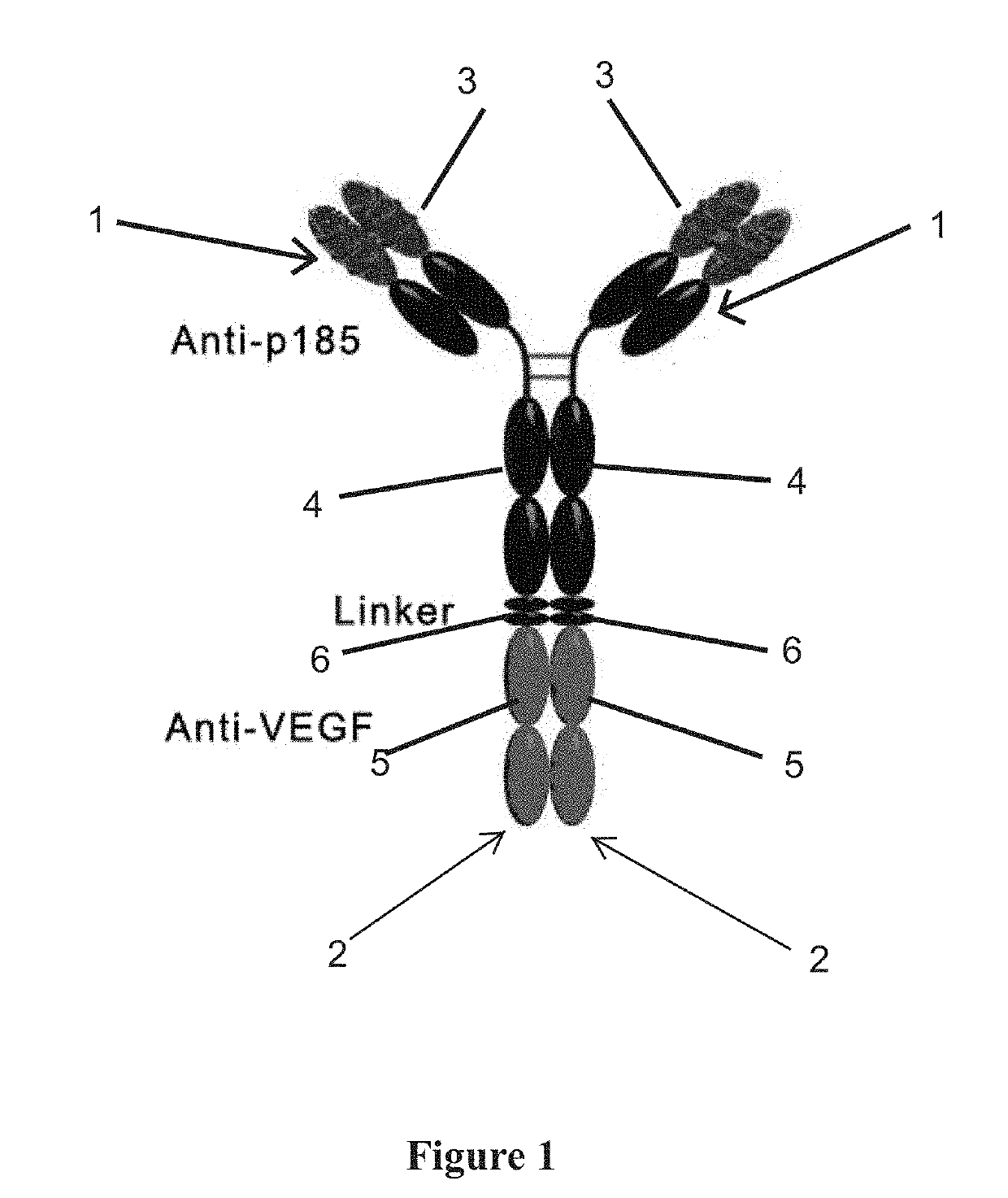Bispecific antibody targeting human p185 and vascular endothelial growth factor and application thereof
a technology of vascular endothelial growth factor and p185, applied in the field of biomedicine, can solve the problems of large amount of nutrients consumed by tumor tissue, large amount of nutrient consumption of infinite proliferation of tumor cells, and difficult to continue to grow tumor tissue, etc., to achieve effective blocking of p185 and vegf proteins at the protein level, and inhibit the proliferation
- Summary
- Abstract
- Description
- Claims
- Application Information
AI Technical Summary
Benefits of technology
Problems solved by technology
Method used
Image
Examples
example 1
[0040]The DNA fragments encoding the anti-p185 antibody, the anti-VEGF antibody and the VEGF binding domain are synthesized. Then, the light chain sequence (SEQ ID NO: 1) and the recombinant heavy chain sequence (SEQ ID NO: 2, SEQ ID NO: 3, SEQ ID NO: 4, or SEQ ID NO: 5) are cloned into the eukaryotic expression vector, pcDNA, respectively. The light chain and the heavy chain DNA are mixed at a mass ratio of 2:1. The DNA mixture (4-10 μg) and 40 μL of 2M CaCl2 are added to a total volume of 250 μL with ddH2O. The whole mixture is added into 250 μL 2×HBS (NaCl 16.3 g, KCl 0.74 g. Na2HPO4 0.214 g, Glucose 2.4 g and HEPES 10 g, pH=7.05) to form a calcium phosphate-DNA suspension which is added into 293F or CHO cells (logarithmic growth phase). The supernatant is collected 5-7 days after the transfection. After filtration through a 0.45 μm filter, the supernatant is added to the affinity chromatography gel column (Protein A) which is washed with binding buffer (12.15 g Tris dissolved in...
example 2
Enzyme-Linked Immunosorbent Assay (ELISA)
[0041]The human p185 and VEGF proteins are coated into 96 well plates for 16 hours and being incubated with PBS buffer containing 1% bovine serum albumin (BSA) at 37° C. for 2 hours. After washing with PBST, it is incubated with the commercially available p185 and VEGF antibody as well as the antibody of the present invention at 37° C. for 2 hours. Following by the PBST washing, anti-human IgG Fab antibody is added for 1 hour. After washing with PBST, tetramethyl benzidine is added for 5 minutes to terminate the reaction. The affinity is measured with the absorbance at 450 nm.
[0042]The ELISA results are shown in FIG. 2. The results suggest that the bispecific antibody targeting both human p185 and VEGF has high affinity with human p185 (FIG. 2(a)), VEGF (FIG. 2(b)), p185-VEGF (FIG. 2(c)), and VEGF-p185 (FIG. 2(d)).
example 3
Western Blotting Assay
[0043](1) The Recognition of VEGF by the Bispecific Antibody
[0044]The HUVEC cells which are morphological health and with the fusion rate of 80% are collected. After centrifugation, the cell lysate is added. The cell lysate is incubated at 95° C. for 10 minutes and is separated by polyacrylamide gel electrophoresis. The protein is transferred into the nitrocellulose membrane (NC membrane) and blocked with 5% milk at room temperature for 1 hour. The bispecific antibody, commercially available VEGF or 1-actin antibody is added and incubated at room temperature for 1 hour. After washing with PBST, the antibody with horseradish peroxidase is added and incubated for 1 hour at room temperature. After washing with PBST, the chemiluminescent reagent is used for developing in the darkroom.
[0045](2) The Recognition of p185 by the Bispecific Antibody
[0046]The MDA-MB-453 cells which are morphological health and with the fusion rate of 80% are collected. After centrifugatio...
PUM
| Property | Measurement | Unit |
|---|---|---|
| Flexibility | aaaaa | aaaaa |
| Nucleic acid sequence | aaaaa | aaaaa |
Abstract
Description
Claims
Application Information
 Login to View More
Login to View More - R&D
- Intellectual Property
- Life Sciences
- Materials
- Tech Scout
- Unparalleled Data Quality
- Higher Quality Content
- 60% Fewer Hallucinations
Browse by: Latest US Patents, China's latest patents, Technical Efficacy Thesaurus, Application Domain, Technology Topic, Popular Technical Reports.
© 2025 PatSnap. All rights reserved.Legal|Privacy policy|Modern Slavery Act Transparency Statement|Sitemap|About US| Contact US: help@patsnap.com



